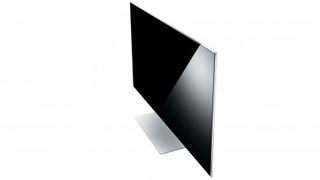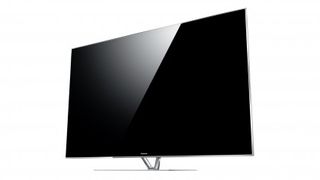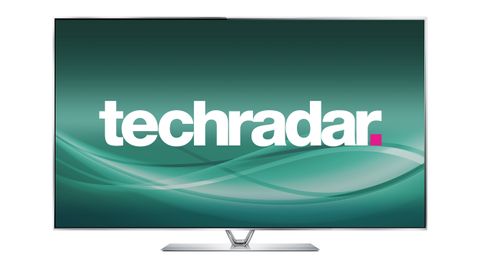Why you can trust TechRadar
And so we get to the moment of truth: has the still-revered Pioneer Kuro plasma TV technology finally met its match with the Panasonic TX-P60ZT65? Happily, very happily, we can answer this question with a resounding yes.
Obviously given all the hype surrounding the Panasonic TX-P60ZT65's contrast performance, it's here that we decided to focus the opening stages of our tests. And what we saw was nothing short of extraordinary.
Probably the best way to sum the situation up is to say that for the first time on any commercially released flat-panel TV, the Panasonic TX-P60ZT65 delivers black colours that actually look black. Not black with a tinge of grey, not black because the screen's just turned off all lighting in the darkest areas, but black in a completely natural, cinematic way that still enables you to see the tiniest shadow details and colour tone shifts in even the most pitch black parts of the image.

It's great to see, too, that this stunning black level perfection is achieved without the picture suffering heavily with the sort of dithering noise that plasma TVs can suffer with in dark areas. This is down, perhaps, to a combination of the Air Gapless design enabling the screen to produce a punchier picture without having to drive the plasma cells so hard, and some unprecedentedly fine controls over the voltage entering each plasma pixel.
If you're still not fully understanding what a big deal the Panasonic TX-P60ZT65's unprecedented black level performance is, the point is that contrast and black level response, in our opinion, provide the foundation for any TV picture. So when a TV gets this sorted as perfectly as the Panasonic TX-P60ZT65 does, it kind of follows that there's every chance that other aspects of the television's picture quality will be equally outstanding.
Plus, of course, being able to watch nearly pitch-black movie scenes without having your attention even slightly distracted by the sort of greyness, backlight clouding/inconsistency and crushed shadow detailing you have to suffer to some degree with all other flat TVs is a revelation, totally transforming your relationship with what you're watching.
Colour performance

Having established the Panasonic TX-P60ZT65's contrast performance as being the best in the TV world to date, it's not entirely surprising to be able to follow this up by marvelling at the Panasonic TX-P60ZT65's colour handling. After all, good black levels usually lead to good colours, so it follows that awesome black levels lead to awesome colours.
The accuracy and incredible subtlety of the Panasonic TX-P60ZT65's colourscape feels borderline miraculous at times, especially when the screen is dealing with particularly high-quality HD sources, such as the opening scene of The Dark Knight on Blu-ray.
What's more, the fidelity of the Panasonic TX-P60ZT65's colours is joined by an engaging level of brightness and vibrancy by plasma standards, making the television more usable than might have been expected in a bright environment. Having said that though, we'd still recommend dark-room viewing if you want to get the maximum impact from all the astonishing, cinematic colour nuancing and shadow detailing the TV has to offer.

The incredibly subtle rendering of colour on the Panasonic TX-P60ZT65 helps it also deliver a sense of sharpness and detail that's nothing short of mesmerising - especially considering that you're witnessing it on a screen as big and immersive as this 60-inch one.
The TV doesn't benefit from a native Ultra HD/4K resolution, but there are times when the joint quality of Panasonic's image processing and uncompromising plasma panel design does make pictures look slightly higher definition than your typical HD TV.
Further help in this respect comes from the Panasonic TX-P60ZT65's freedom from the motion blurring problems associated to some degree with even the very best LCD TVs. This is one of plasma's biggest advantages as a technology, and the Panasonic TX-P60ZT65 makes the most of it. Or at least, it makes the most of it if you take the plunge and activate Panasonic's Intelligent Frame Creation processing on its lowest setting.
Motion processing

Normally we wouldn't tend to recommend using motion processing systems on TVs. But the processing engine in the Panasonic TX-P60ZT65 is so powerful and so thoughtfully defined that it goes about its business without leaving the picture looking too processed.
What's more, if you don't use the system, you lay yourself open to suffering with pretty much the only two flaws in the Panasonic TX-P60ZT65's picture make-up: a little double imaging around the edges of moving objects and some fizzing noise over moving skin tones.
Without the IFC set to Low these issues can be quite distracting - especially with broadcast sources. But with the IFC on, they pretty much cease to be a problem.

Having been slightly negative about broadcast source handling back there, though, we need to stress that our only gripe with the Panasonic TX-P60ZT65's broadcast images is the (ultimately avoidable) motion niggles.
In every other way the TV is unprecedentedly good with broadcast footage, thanks to the provided EBU preset. Simply activating this preset, without having to do any further calibration tweaks, is an absolute revelation, as the image's colour balance, noise handling, contrast and white balance revert to settings designed by broadcasters to make sure you're getting a totally authentic picture.
The THX modes are similarly astutely designed to give you instantly great images when watching films. This is significant, because we haven't always felt entirely comfortable with THX presets on previous plasma generations. But it seems on the TX-P60ZT65 as if Panasonic has got its plasma technology to a point where it can fully meet the vision and demands of the THX specification.
3D picture

So far we've just been talking about 2D footage on the Panasonic TX-P60ZT65, but rest assured that it's also brilliant with 3D. The amount of detail in its 3D images is sensational, reminding you in no uncertain terms why the full-resolution active 3D system is still a potent force, especially on large screen TVs.
The clarity with which this detail is delivered is outstanding too, with practically no noise to worry about. Even crosstalk ghosting noise, that perennial bane of active 3D playback, is practically non-existent. And thanks to the clarity of the 3D picture, you also get a superb and consistent sense of 3D depth and space.
The Panasonic TX-P60ZT65 does follow other Panasonic 3D plasma televisions by taking quite a lot of brightness out of its 3D images. But the pros far outweigh the cons, and if you can manage to watch 3D in a dark room wherever possible, the brightness reduction isn't a major blow by any means.
AV Technology Contributor
John has been writing about home entertainment technology for more than two decades - an especially impressive feat considering he still claims to only be 35 years old (yeah, right). In that time he’s reviewed hundreds if not thousands of TVs, projectors and speakers, and spent frankly far too long sitting by himself in a dark room.

Meta’s massive OS announcement is more exciting than a Meta Quest 4 reveal, and VR will never be the same again

World's fastest broadband connection went live down under — Nokia demos 100 gigabit internet line in Australia in record-breaking attempt but doesn't say when it will go on sale

Don't miss the Samsung Galaxy S23 Ultra for just $849 at Best Buy right now

